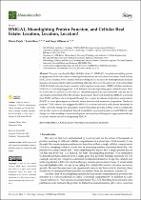| dc.contributor | Vall d'Hebron Barcelona Hospital Campus |
| dc.contributor.author | Pujals-Pruneda, Mireia |
| dc.contributor.author | Resar, Linda |
| dc.contributor.author | Villanueva Cardús, Josep |
| dc.date.accessioned | 2022-06-16T06:39:54Z |
| dc.date.available | 2022-06-16T06:39:54Z |
| dc.date.issued | 2021-09-09 |
| dc.identifier.citation | Pujals M, Resar L, Villanueva J. HMGA1, Moonlighting Protein Function, and Cellular Real Estate: Location, Location, Location! Biomolecules. 2021 Sep 9;11(9):1334. |
| dc.identifier.issn | 2218-273X |
| dc.identifier.uri | https://hdl.handle.net/11351/7695 |
| dc.description | HMGA1; Secretome; Unconventional protein secretion |
| dc.description.abstract | The gene encoding the High Mobility Group A1 (HMGA1) chromatin remodeling protein is upregulated in diverse cancers where high levels portend adverse clinical outcomes. Until recently, HMGA1 was assumed to be a nuclear protein exerting its role in cancer by transcriptionally modulating gene expression and downstream signaling pathways. However, the discovery of an extracellular HMGA1-RAGE autocrine loop in invasive triple-negative breast cancer (TNBC) cell lines implicates HMGA1 as a “moonlighting protein” with different functions depending upon cellular location. Here, we review the role of HMGA1, not only as a chromatin regulator in cancer and stem cells, but also as a potential secreted factor that drives tumor progression. Prior work found that HMGA1 is secreted from TNBC cell lines where it signals through the receptor for advanced glycation end products (RAGE) to foster phenotypes involved in tumor invasion and metastatic progression. Studies in primary TNBC tumors also suggest that HMGA1 secretion associates with distant metastasis in TNBC. Given the therapeutic potential to target extracellular proteins, further work to confirm this role in other contexts is warranted. Indeed, crosstalk between nuclear and secreted HMGA1 could change our understanding of tumor development and reveal novel therapeutic opportunities relevant to diverse human cancers overexpressing HMGA1. |
| dc.language.iso | eng |
| dc.publisher | MDPI |
| dc.relation.ispartofseries | Biomolecules;11(9) |
| dc.rights | Attribution 4.0 International |
| dc.rights.uri | http://creativecommons.org/licenses/by/4.0/ |
| dc.source | Scientia |
| dc.subject | Oncogens |
| dc.subject | Càncer |
| dc.subject.mesh | Neoplasms |
| dc.subject.mesh | HMGA1a Protein |
| dc.subject.mesh | /metabolism |
| dc.subject.mesh | Oncogenes |
| dc.title | HMGA1, Moonlighting Protein Function, and Cellular Real Estate: Location, Location, Location! |
| dc.type | info:eu-repo/semantics/article |
| dc.identifier.doi | 10.3390/biom11091334 |
| dc.subject.decs | neoplasias |
| dc.subject.decs | proteína HMGA1a |
| dc.subject.decs | /metabolismo |
| dc.subject.decs | oncogenes |
| dc.relation.publishversion | https://doi.org/10.3390/biom11091334 |
| dc.type.version | info:eu-repo/semantics/publishedVersion |
| dc.audience | Professionals |
| dc.contributor.organismes | Institut Català de la Salut |
| dc.contributor.authoraffiliation | [Pujals M] Vall d’Hebron Institute of Oncology (VHIO), Barcelona, Spain. [Resar L] Department of Medicine, Division of Hematology, The Johns Hopkins University School of Medicine, Baltimore, USA. Departments of Medicine (Hematology), Oncology, Pathology and Institute of Cellular Engineering, The Johns Hopkins University School of Medicine, Baltimore, USA. Pathobiology, Cellular and Molecular Medicine and Human Genetics Graduate Programs, The Johns Hopkins University School of Medicine, Baltimore, USA. [Villanueva J] Vall d’Hebron Institute of Oncology (VHIO), Barcelona, Spain. Centro de Investigación Biomédica en Red de Cáncer (CIBERONC), Madrid, Spain |
| dc.identifier.pmid | 34572547 |
| dc.identifier.wos | 000699120800001 |
| dc.relation.projectid | info:eu-repo/grantAgreement/ES/PE2017-2020/PI19%2F01292 |
| dc.rights.accessrights | info:eu-repo/semantics/openAccess |

 Private area
Private area Contact Us
Contact Us







